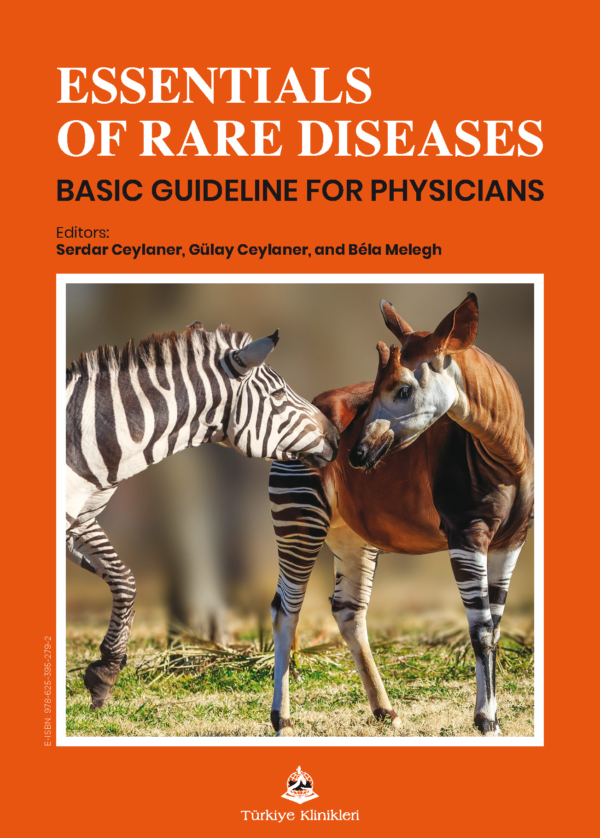Açık erişimli PDF’ine erişmek için tıklayınız.
Including – Basic genetics for all medical doctors
“Rare, but still human”
Dear rare disease volunteer,
This booklet has been prepared to guide you through the key aspects of rare diseases and to serve as your roadmap. It does not cover every rare disease and everything about this issue but focuses on essential information. Studying rare diseases is challenging, yet it is a skill that can be acquired, and solutions can be found.
The main principles outlined here include:
- Believing that medicine needs to evolve,
- Being willing to abandon some old habits,
- Keeping in mind the possibility that “your patient may have a rare disease,” and consulting more experienced colleagues within European Reference Networks
- Understanding that research on rare diseases involves working until the etiology, whether rare or common, is identified. This approach contributes to providing the highest quality and most cost-effective healthcare services, as in any other diseases,
- Recognizing that a definitive diagnosis ensures the correct treatment, protects against the risk of recurrence in the next generations of the patient and their family, and leads to a longer and higher-quality life,
- Realizing that only through multidisciplinary collaboration, patients with rare diseases can be served
- Striving to increase accessibility to new diagnostic technologies, such as genomic technolo- gies. If you do not have such a team, please use your e-mail,
- Supporting patients with rare diseases in organizing themselves,
- Feeling like a member of rare disease community,
- Engaging in preventive medicine using new-generation
These studies will make you feel more capable as a physician, enable you to participate in scien- tific studies of rare diseases, and make you feel like a member of a multi-disciplinary team.
The European exam is one of the important steps in the formation of a rare disease commu- nity. This exam aims to measure core competencies. This is the first step. Once a community with competencies is formed, it is possible to draw new road maps. Physicians who specialize in certain areas and on rare diseases see the rare disease world within the boundaries of their field of expertise. We must expand our world and become a general physician, but one who specializes in a particular field.
The rare disease physician must constantly ask “why?”. Why are my patient’s symptoms different? Why did the treatment fail? Why is the patient still not happy. Why did he/she expe- rience complications? etc.
In this booklet;
A little summary on some of the titles to help you to learn easier, and further readings are sug- gested.
The main aim to help you to understand these basic principles of rare diseases and prepare you for the European exam. In future versions of this booklet, we plan to add chapters for all medical specialties to add their own rare diseases and their red flags.
If you are new, welcome to the rare disease community. We recommend you to;
Please read UEMS- Multidisciplinary Joint Committee of Rare and Undiagnosed Diseases (MJC- RUD) documents
- Description of Competency
- ETR
- Syllabus
- https://mjcrud-pte.hu/
- https://mjcrud-pte.hu/content/etrs
- This booklet gives you a summary of some important topics and some further reading sug- gestions. Rather than providing information about rare diseases, the summaries are intended to provide you with experiences regarding rare diseases and to help you gain the necessary perspective for rare disease diagnosis.
- Considering that a significant portion of rare diseases are genetic diseases, try to master the basic information about genetics.
- The aim of the European exam is not to question the details about rare diseases, but to deter- mine that the physician knowledge on the rare disease red flags and uses the necessary algo- rithms when evaluating a patient who may have a rare disease.
Some important notes;
A significant portion of rare diseases are diseases that have a genetic basis. Therefore, this booklet about rare diseases contains a lot of genetic information and links to resources containing some ge- netic information are included. UEMS Medical Genetics exam is an exam to certify the equivalence of medical genetics specialty diplomas across Europe and is organized by the Section of Medical Ge- netics (SMG). Two of three editors also a member of SMG and part of the SMG examination commit- tee. U.E.M.S. – Multidisciplinary Joint Committee – Rare And Undiagnosed Diseases (MJC-RUD) exam is a competency evaluation exam. It is not intended to lead to a specialist degree and is open to other specialists as well as Medical Geneticists. You can see the details on the MJC-RUD website.
UEMS does not have any plans or efforts to prepare books for exams. This study was not conducted on behalf of UEMS or due to an assignment given to it. This booklet aims to provide both a scientific contribution and a perspective for those who will take the exam. It is important for all specialists dealing with rare diseases to have a good grasp of the general perspective and to know rare disease flags.
Another important issue is that since the author’s native language is not English and he is trying to prepare a book with a low budget, the content was prepared by the author and grammar checks were made by artificial intelligence. I think that Medical Geneticists like us, who have a field of expertise that loves new technologies, and rare disease enthusiast physicians who look to the future, should internalize these technologies more and more every day and devote our financial resources and time to our patients and science.
Finally, as a writer, I would like to express my gratitude to Prof Jean Calleja Agius, who encour- aged and motivated the creation of this booklet; to Prof Reinold (Rijk) Gans, Prof Ambrogio Fassina and Dr Hasan Baş for their contributions and suggestions by reading the content in addition to their motivation. I would like to express my gratitude to my dear wife, my love and my dear companion, Assoc. Prof. Gülay Ceylaner, who not only contributed to the content of the book but also drew the graphics, was always by my side with her moral support, and took all my other work away from me while I was preparing the book. I would like to give a special thanks to my dear friend and president of MJC-RUD, Prof Béla Melegh, who has supported me in the field of rare diseases, to which I have devoted my professional life, and who has been with me and guided me at all stages of the book process.
Serdar Ceylaner
MJC-RUD Vice-President and Writer
Gülay Ceylaner
Bela Melegh
MJC-RUD President



